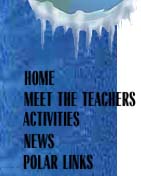
|
|
Transfer to Classrooms: Brain-Storming and Some Models
Orientation Brain-Storming Sessions
Before Leaving
Have students generate questions and focus journal topics on sharing info about those questions
Model what is happening (inc. simplified version of equipment if necessary)
History of project and/or technology
Check alignment of your project with curriculum (may not necessarily be in your grade), look to establish relationships with teachers whose curriculum who may have a match with your project.
Put together information packet (may include e-mail, or web page)
During
Include daily questions
Send lots of pictures with your journal.... it's okay to include long captions on pictures
After
remember you can continue to use journals after leaving, esp. if you are doing something related to polar research
year-long environmental site research
mimic research techniques in local environment
compare and contrast environments
idederots
visit other places in Alaska
Have contact in other schools, other TEAs
Have each student/group follow a parcticular TEA. Have individual/groups give periodic updates to class.
Some Models
Betty Trummel:
Created packet for teachers that included:
Antarctica/Polar Connections
How to get to website and how to navigate
Overhead on North and South poles activity (what happens where)
Pictures of herself in polar gear
Card of her contact information
Cover letter
Sent packet colleagues and friends in as many states as possible -
requested they share with their classrooms
Developed a spreadsheet to keep track of speaking engagements
Dressed students in gear
Shared books and other resources
Responded to ~ 40/60 letters each day while in the field
Provides flyers for Illinois teacher conventions
Receives district help to cover the expenses of packages, travel, time off, etc.
Finds her experience pays off in feedback
Currently presents 2-3 times each week (includes pre-service teachers, rotary club. advisory board, other districts, etc.)
Hillary Tulley:
Made gigantic resources list that included two highly recommended books (The Worst Journey in the World and Below the Convergence), map resources, locations for aerial photograph acquisition, videos, etc.
Recommended use of the resources from other TEAs - collaborate!
Spoke with ~200 students before she went to the field
Continues with in-services
Shares ideas and program with committees and curriculum teams at the state level
Elke Bergholz
Maintained contact with other teachers at her school
Created a packet of information for each teacher contacted - mailed this ~2-3 weeks before she went into the field
Provided an itinerary of her research schedule so others could follow
Provided background on science content, summery with questions for class, ozone websites, etc.
Sent data back to classrooms interested in analyzing information and following her research
Carried T-shirts and school flags for images at the Pole
Created folders for her students about her polar work so that they would feel like they were part of the adventure
Encouraged junior high and middle school art and geography classes to follow her.
Parcticipated in 2 presentations each week
Hosted CU-SeeMe sessions (note that schools need to be prepared for
using the technology)
Sent letters to the entire educational community (e.g., cooks, janitors, etc.)
Specific resources taken to classrooms included a stuffed or inflatable penguin or polar bear, videos (Cancer of the Sky; Warnings from the Ice), etc.
Pursued inclusion in local newspapers and news
Included a summary on the school Web site
Tim Conner:
Shares the culture of the Arctic by tying Innuit classrooms to the teacheršs
classroom.
Focuses on the children of the culture, not the adults. Best if the students can
connect with each other without the TEA or other teachers in the middle.
Has his classes interact through e-mail, CU-SeeMe with Alaskan classrooms;
students are engaged at a personal and scholastic level.
Summer experience challenged connections to classrooms; brought experience
to the classrooms in the following fall.
Back to: TEA
Information Front Page
|


